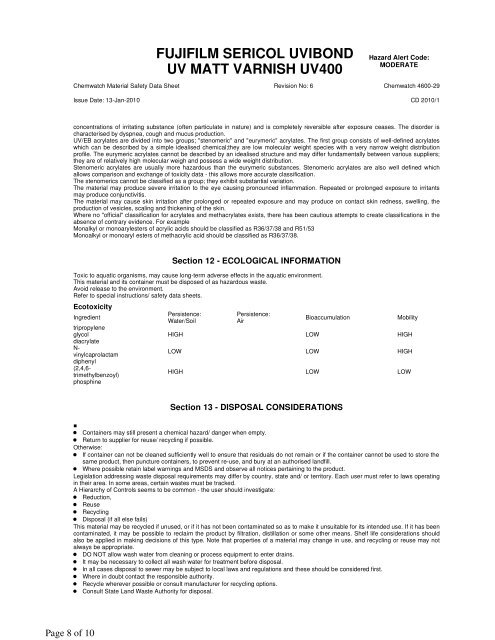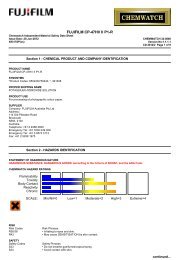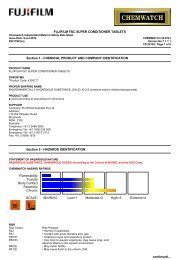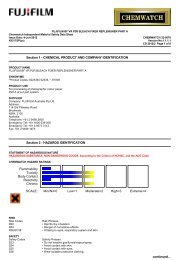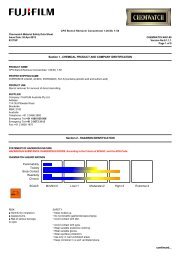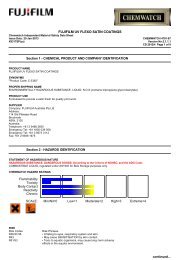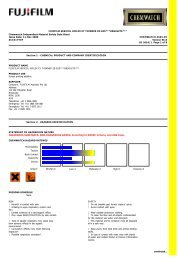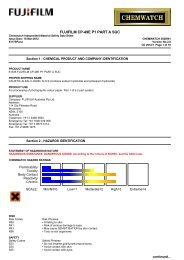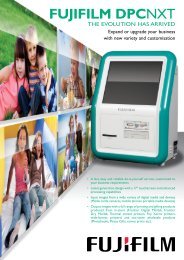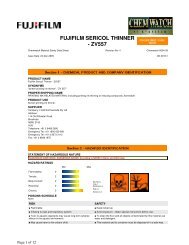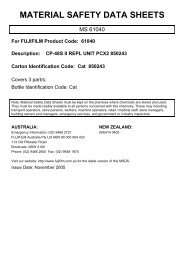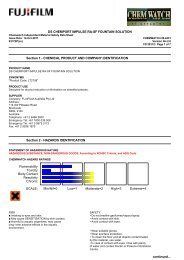fujifilm sericol uvibond uv matt varnish uv400 - FUJIFILM Australia
fujifilm sericol uvibond uv matt varnish uv400 - FUJIFILM Australia
fujifilm sericol uvibond uv matt varnish uv400 - FUJIFILM Australia
You also want an ePaper? Increase the reach of your titles
YUMPU automatically turns print PDFs into web optimized ePapers that Google loves.
<strong>FUJIFILM</strong> SERICOL UVIBONDUV MATT VARNISH UV400Hazard Alert Code:MODERATEChemwatch Material Safety Data Sheet Revision No: 6 Chemwatch 4600-29Issue Date: 13-Jan-2010 CD 2010/1concentrations of irritating substance (often particulate in nature) and is completely reversible after exposure ceases. The disorder ischaracterised by dyspnea, cough and mucus production.UV/EB acrylates are divided into two groups; "stenomeric" and "eurymeric" acrylates. The first group consists of well-defined acrylateswhich can be described by a simple idealised chemical;they are low molecular weight species with a very narrow weight distributionprofile. The eurymeric acrylates cannot be described by an idealised structure and may differ fundamentally between various suppliers;they are of relatively high molecular weigh and possess a wide weight distribution.Stenomeric acrylates are usually more hazardous than the eurymeric substances. Stenomeric acrylates are also well defined whichallows comparison and exchange of toxicity data - this allows more accurate classification.The stenomerics cannot be classified as a group; they exhibit substantial variation.The material may produce severe irritation to the eye causing pronounced inflammation. Repeated or prolonged exposure to irritantsmay produce conjunctivitis.The material may cause skin irritation after prolonged or repeated exposure and may produce on contact skin redness, swelling, theproduction of vesicles, scaling and thickening of the skin.Where no "official" classification for acrylates and methacrylates exists, there has been cautious attempts to create classifications in theabsence of contrary evidence. For exampleMonalkyl or monoarylesters of acrylic acids should be classified as R36/37/38 and R51/53Monoalkyl or monoaryl esters of methacrylic acid should be classified as R36/37/38.Section 12 - ECOLOGICAL INFORMATIONToxic to aquatic organisms, may cause long-term adverse effects in the aquatic environment.This material and its container must be disposed of as hazardous waste.Avoid release to the environment.Refer to special instructions/ safety data sheets.EcotoxicityIngredienttripropyleneglycoldiacrylateN-vinylcaprolactamdiphenyl(2,4,6-trimethylbenzoyl)phosphinePersistence:Water/SoilPersistence:AirBioaccumulationMobilityHIGH LOW HIGHLOW LOW HIGHHIGH LOW LOWSection 13 - DISPOSAL CONSIDERATIONS■ Containers may still present a chemical hazard/ danger when empty. Return to supplier for reuse/ recycling if possible.Otherwise: If container can not be cleaned sufficiently well to ensure that residuals do not remain or if the container cannot be used to store thesame product, then puncture containers, to prevent re-use, and bury at an authorised landfill. Where possible retain label warnings and MSDS and observe all notices pertaining to the product.Legislation addressing waste disposal requirements may differ by country, state and/ or territory. Each user must refer to laws operatingin their area. In some areas, certain wastes must be tracked.A Hierarchy of Controls seems to be common - the user should investigate: Reduction, Reuse Recycling Disposal (if all else fails)This material may be recycled if unused, or if it has not been contaminated so as to make it unsuitable for its intended use. If it has beencontaminated, it may be possible to reclaim the product by filtration, distillation or some other means. Shelf life considerations shouldalso be applied in making decisions of this type. Note that properties of a material may change in use, and recycling or reuse may notalways be appropriate. DO NOT allow wash water from cleaning or process equipment to enter drains. It may be necessary to collect all wash water for treatment before disposal. In all cases disposal to sewer may be subject to local laws and regulations and these should be considered first. Where in doubt contact the responsible authority. Recycle wherever possible or consult manufacturer for recycling options. Consult State Land Waste Authority for disposal.Page 8 of 10


